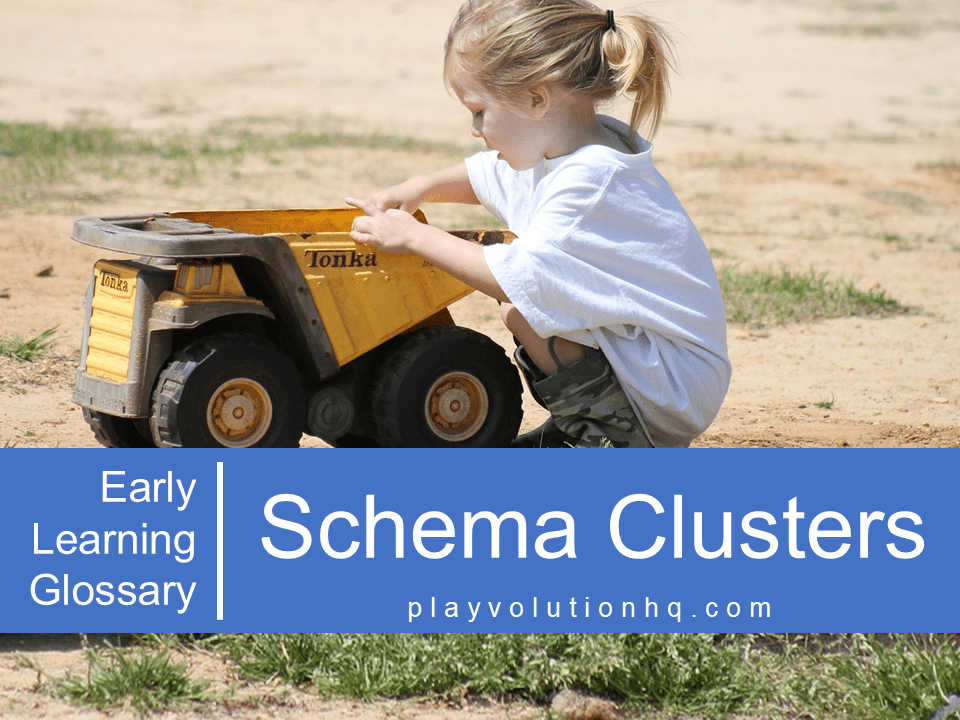
Table of Contents
Schema clusters are the natural grouping of related play schemas that children explore simultaneously.
Let’s backtrack a bit.
First, What’s Schema Play?
The theory behind schema play is that children enjoy repeating patterns of behavior during their play and exploration. This repetition helps them gain, understand, and organize information and knowledge of the world.
Have you ever observed children repeating certain actions during play: filling and dumping containers, pushing toy cars back and forth, or spinning in circles, for example? These repeated behaviors are more than just fun activities; they’re examples of schemas and play a crucial role in children learning about the world. You’ll find a handout with a dozen common schemas here.
Back To Schema Clusters
Sometimes, a child’s play combines multiple schemas. These schema clusters indicate the child is engaging in a more complex form of learning. Schema clusters allow children to build on their understanding by linking different behavior patterns, leading to more comprehensive cognitive development.
For example, three-year-old Felix might be fascinated by both transporting and enveloping. They may fill a bag with toys (transporting) and then wrap it in a blanket (enveloping). This combination of actions helps the child understand concepts like containment, movement, and boundaries—all in one playful experience.
Interconnected Complexity
Schema clusters are significant because they reflect how children’s learning is interconnected. By clustering schemas, children are not just focusing on isolated actions but are integrating various concepts to explore more complex ideas. This integrated learning approach enhances their cognitive development, problem-solving skills, and understanding of the world around them.

Examples of Schema Clusters
Here are some common schema clusters you might observe:
- Transporting And Enveloping–A child might enclose toys in a cardboard box (enveloping) and then push the box across the room(transporting), exploring the concepts of movement and containment.
- Rotation And Trajectory–Spinning a ball on a flat surface (rotation) and then rolling it down a ramp (trajectory) helps the child understand circular motion and directional movement.
- Enclosure And Containing–Building a fort with blocks (enclosing) and then placing toys inside it (containing) allows the child to explore boundaries, spatial relations, and object permanence.
- Positioning And Rotation–Turning a riding toy upside down (positioning) and then spinning its wheels (Rotation) encourages the child to think about perspective and motion.

Supporting Schema Clusters
Providing large blocks of time for self-directed play and exploration is the best way to support schema clustering. Loose parts are ideal for play and exploration since children can combine them in interesting ways, leading to unending variety and versatility. Observing children’s play to identify the schemas they are interested in and then introducing related materials that allow them to combine other schemas also helps.
Allowing children the freedom to explore and combine schemas during play will enhance their cognitive development and help them build a richer understanding of the world.
Wrap-Up
Parents and caregivers can foster more meaningful and complex learning experiences by observing and supporting schema clusters during play. Encourage kids to explore, combine, and create, knowing they engage in essential cognitive development through such play.
If you’re looking for more on schema play, check out these links:
Contribute content to Playvolution HQ
Brought to you by Explorations Early Learning
Thoughts On This Entry?
I’d love to hear your thoughts on improving this entry and suggestions for additional glossary additions in the comments below. You can also contact me with comments or concerns.
Browse Trainings
Post Author
Jeff Johnson is an early learning trainer, podcaster, and author who founded Explorations Early Learning, Playvolution HQ, and Play Haven.


Leave a Reply